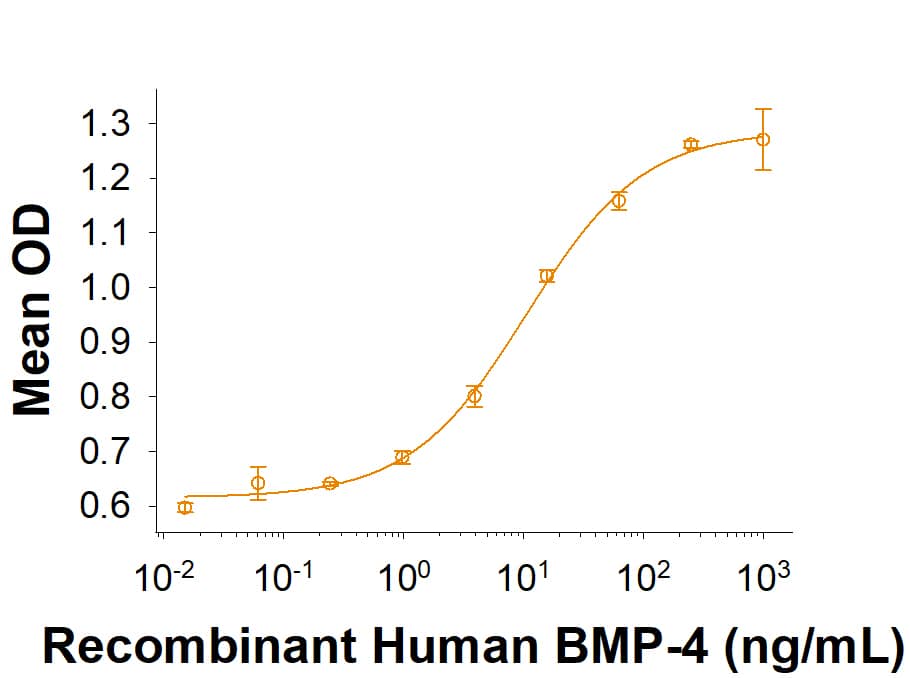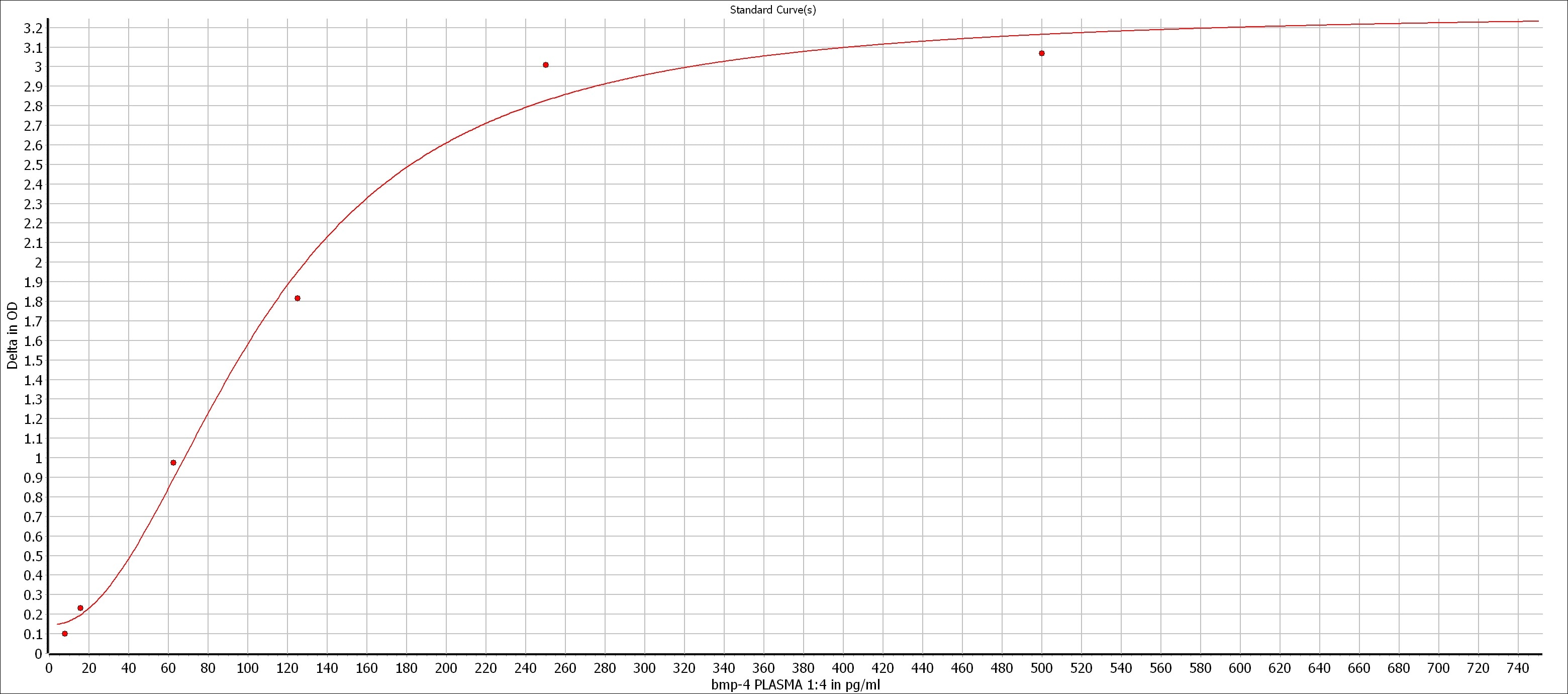Human BMP-4 DuoSet ELISA Summary
* Provided that the recommended microplates, buffers, diluents, substrates and solutions are used, and the assay is run as summarized in the Assay Procedure provided.
This DuoSet ELISA Development kit contains the basic components required for the development of sandwich ELISAs to measure natural and recombinant human BMP-4. The suggested diluent is suitable for the analysis of most cell culture supernate samples. Diluents for complex matrices, such as serum and plasma, should be evaluated prior to use in this DuoSet.
Customers also Viewed
Product Features
- Optimized capture and detection antibody pairings with recommended concentrations save lengthy development time
- Development protocols are provided to guide further assay optimization
- Assay can be customized to your specific needs
- Economical alternative to complete kits
Kit Content
- Capture Antibody
- Detection Antibody
- Recombinant Standard
- Streptavidin conjugated to horseradish-peroxidase (Streptavidin-HRP)
Other Reagents Required
DuoSet Ancillary Reagent Kit 2 (5 plates): (Catalog # DY008) containing 96 well microplates, plate sealers, substrate solution, stop solution, plate coating buffer (PBS), wash buffer, and Reagent Diluent Concentrate 2.
The components listed above may be purchased separately:
PBS: (Catalog # DY006), or 137 mM NaCl, 2.7 mM KCl, 8.1 mM Na2HPO4, 1.5 mM KH2PO4, pH 7.2 - 7.4, 0.2 µm filtered
Wash Buffer: (Catalog # WA126), or 0.05% Tween® 20 in PBS, pH 7.2-7.4
Reagent Diluent: (Catalog # DY995), or 1% BSA in PBS, pH 7.2-7.4, 0.2 µm filtered
Substrate Solution: 1:1 mixture of Color Reagent A (H2O2) and Color Reagent B (Tetramethylbenzidine) (Catalog # DY999)
Stop Solution: 2 N H2SO4 (Catalog # DY994)
Microplates: R&D Systems (Catalog # DY990)
Plate Sealers: ELISA Plate Sealers (Catalog # DY992)
Scientific Data
Product Datasheets
Preparation and Storage
Background: BMP-4
BMPs are secreted signaling molecules that comprise a subfamily of the TGF-beta superfamily and were originally identified as regulators of cartilage and bone formation. There are at least 20 structurally and functionally related BMPs, most of which play roles in embryogenesis and morphogenesis of various tissues and organs. Biologically active BMPs are usually homodimers containing a characteristic cysteine knot structure. Heterodimers, BMP-2/BMP-7 and BMP-4/BMP-7 have also been suggested to exist and function in vivo. They are more potent inducers of bone formation than their respective homodimers. In addition, heterodimers, but not homodimers, are ventral mesoderm inducers. Heterodimer activity may be mediated by a different or additional receptor subtype.
Decapentaplegic (Dpp) is one of at least five TGF-beta superfamily ligands identified in the Drosophila genome. Dpp, a functional ortholog of mammalian BMP-2 and BMP-4, is a morphogen and plays an essential role in Drosophila development. Dpp regulates embryonic dorsal-ventral polarity and is required for gut morphogenesis and outgrowth and patterning of imaginal disks.
Assay Procedure
GENERAL ELISA PROTOCOL
Plate Preparation
- Dilute the Capture Antibody to the working concentration in PBS without carrier protein. Immediately coat a 96-well microplate with 100 μL per well of the diluted Capture Antibody. Seal the plate and incubate overnight at room temperature.
- Aspirate each well and wash with Wash Buffer, repeating the process two times for a total of three washes. Wash by filling each well with Wash Buffer (400 μL) using a squirt bottle, manifold dispenser, or autowasher. Complete removal of liquid at each step is essential for good performance. After the last wash, remove any remaining Wash Buffer by aspirating or by inverting the plate and blotting it against clean paper towels.
- Block plates by adding 300 μL Reagent Diluent to each well. Incubate at room temperature for a minimum of 1 hour.
- Repeat the aspiration/wash as in step 2. The plates are now ready for sample addition.
Assay Procedure
- Add 100 μL of sample or standards in Reagent Diluent, or an appropriate diluent, per well. Cover with an adhesive strip and incubate 2 hours at room temperature.
- Repeat the aspiration/wash as in step 2 of Plate Preparation.
- Add 100 μL of the Detection Antibody, diluted in Reagent Diluent, to each well. Cover with a new adhesive strip and incubate 2 hours at room temperature.
- Repeat the aspiration/wash as in step 2 of Plate Preparation.
- Add 100 μL of the working dilution of Streptavidin-HRP to each well. Cover the plate and incubate for 20 minutes at room temperature. Avoid placing the plate in direct light.
- Repeat the aspiration/wash as in step 2.
- Add 100 μL of Substrate Solution to each well. Incubate for 20 minutes at room temperature. Avoid placing the plate in direct light.
- Add 50 μL of Stop Solution to each well. Gently tap the plate to ensure thorough mixing.
- Determine the optical density of each well immediately, using a microplate reader set to 450 nm. If wavelength correction is available, set to 540 nm or 570 nm. If wavelength correction is not available, subtract readings at 540 nm or 570 nm from the readings at 450 nm. This subtraction will correct for optical imperfections in the plate. Readings made directly at 450 nm without correction may be higher and less accurate.
Citations for Human BMP-4 DuoSet ELISA
R&D Systems personnel manually curate a database that contains references using R&D Systems products. The data collected includes not only links to publications in PubMed, but also provides information about sample types, species, and experimental conditions.
7
Citations: Showing 1 - 7
Filter your results:
Filter by:
-
Improving the secretory capacity of CHO producer cells: The effect of controlled Blimp1 expression, a master transcription factor for plasma cells
Authors: SH Kim, M Baek, S Park, S Shin, JS Lee, GM Lee
Metabolic engineering, 2021-11-11;69(0):73-86.
Species: Human
Sample Types: Recombinant Protein
-
Detection of circulating BMP5 as a risk factor for Barrett's esophagus
Authors: ACP Correia, S Calpe, N Mostafavi, SJM Hoefnagel, MDC Sancho-Ser, PS de Koning, KK Krishnadat
Scientific Reports, 2020-09-23;10(1):15579.
Species: Human
Sample Types: Serum
-
Improving recombinant bone morphogenetic protein-4 (BMP-4) production by autoregulatory feedback loop removal using BMP receptor-knockout CHO cell lines
Authors: CL Kim, GM Lee
Metab. Eng., 2018-11-14;0(0):.
Species: Chinese Hamster
Sample Types: Cell Culture Supernates
-
Gelatin device for the delivery of growth factors involved in endochondral ossification
Authors: LA Ahrens, D Vonwil, J Christense, VP Shastri
PLoS ONE, 2017-04-05;12(4):e0175095.
Species: Human
Sample Types: Recombinant Protein
-
The association between BMP4 gene polymorphism and its serum level with the incidence of LVH in hypertensive patients.
Authors: Gu G, Yang Q, Zeng R, Xu X
J Transl Med, 2015-01-16;13(0):14.
Species: Human
Sample Types: Serum
-
BMP4 inhibits breast cancer metastasis by blocking myeloid-derived suppressor cell activity.
Authors: Cao Y, Slaney C, Bidwell B, Parker B, Johnstone C, Rautela J, Eckhardt B, Anderson R
Cancer Res, 2014-09-15;74(18):5091-102.
Species: Mouse
Sample Types: Cell Culture Supernates
-
Bone morphogenetic protein 4 is induced in hepatocellular carcinoma by hypoxia and promotes tumour progression.
Authors: Maegdefrau U, Amann T, Winklmeier A
J. Pathol., 2009-08-01;218(4):520-9.
Species: Human
Sample Types: Cell Lysates
FAQs
No product specific FAQs exist for this product, however you may
View all ELISA FAQsDuoSet Ancillary Reagent Kits
Supplemental ELISA Products
Reviews for Human BMP-4 DuoSet ELISA
Average Rating: 3 (Based on 1 Review)
Have you used Human BMP-4 DuoSet ELISA?
Submit a review and receive an Amazon gift card.
$25/€18/£15/$25CAN/¥75 Yuan/¥2500 Yen for a review with an image
$10/€7/£6/$10 CAD/¥70 Yuan/¥1110 Yen for a review without an image
Filter by:














